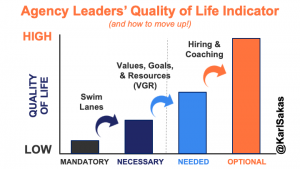Each year, the Content Marketing Institute (CMI) neatly rounds things off by publishing the results of its regional Content Marketing: Budgets, Benchmarks and Trends marketer surveys. We wanted to digest the UK results more thoroughly, so we grabbed a few minutes with Lisa Murton Beets, Research Director at the Content Marketing Institute. What’s immediately striking is, firstly, how things have matured in the content world, secondly, what successful companies are doing to create that maturity, and thirdly, how committed they’ve become to the practice.
“This year we made a lot of changes to our survey, far more so than in the past,” Lisa explains. “We wanted to get more insights and more opinions on content marketing.”
The CMI’s Content Marketing in the UK 2017: Budgets, Benchmarks and Trends survey dug a little deeper into documented content marketing. Year on year these surveys prove the value of having a documented content strategy, with those that do rating their strategy as ‘effective’. This year, however, marketers were asked about their success and how they feel about it. Six out ten UK marketers are committed to content marketing; they’ve bought into it, and that’s because their efforts thus far are breeding tangible success.
“We’re seeing the word ‘success’, as opposed to ‘effective’, a lot more,” says Lisa. “So we’re looking a lot more at the strategy itself and how that translates – what elements marketers use, what metrics they’re looking at, and what’s actually getting results. This year we focused more specifically on the tactics that are working for marketers, particularly those that rate their content marketing strategy as ‘sophisticated’ or ‘mature’.”
A big surprise?
Here’s where we come to the big reveal – the tactic that UK marketers feel is critical to both content marketing effectiveness and metrics-driven success, is blogging.
Yep, the humble blog. After all the showboating and the kooky campaigns, after straining ourselves to understand evermore perplexing new social channels and digital tools, it’s the blog that wins out.
Overwhelmingly so, too. Lisa tells me that the email newsletter is the most favoured content marketing technique in the US and Australia, but here in Blighty, 74% of respondents say that blogging will be their critical driver of success, followed at a fair distance by email, which is favoured by 50% of respondents.
Either way, it’s gratifying to see a validation of the more ‘traditional’ content marketing techniques, so to speak. What gets those qualified leads is a good old, well researched, expertly vetted blog. Which kind of feels like we’re rounding off the year by getting back to our roots. I like that.
It’s gratifying to see a validation of the more ‘traditional’ content marketing techniques
Be clear
Another key point to emerge from the survey is that of clarity. The question of whether you are clear on why you’re employing a particular content marketing tactic is crucial your success rate.
“The marketers that rate their strategies as ‘sophisticated’ or ‘mature’ have more clarity – they know what’s expected of them,” explains Lisa. “If you work in content marketing, but your boss isn’t telling you the pros – if you’re asking yourself ‘why am I sitting here?’ and ‘why am I doing this?’ – that can be a problem.”
This is exactly why the CMI continues to drum in the message that brands must have a thoroughly documented content marketing strategy. To be successful, you need everyone on the same page. You need to know what success looks like and how to get there.
The marketers that rate their strategies as ‘sophisticated’ or ‘mature’ have more clarity – they know what’s expected of them
Strategy issues
Those that did not rate their content marketing maturity or success highly generally had strategy issues. In some cases, that’s because they don’t have a strategy in place, which has an additive effect. Many marketers at the lower end of the success spectrum admit they simply did not have time to commit to a documented strategy, which ultimately resulted in a lot of untargeted content that had no end goal or valuable audience in mind.
“Can it be said there’s too much content? I think so,” says Lisa. “We’ve been saying that for a while. We keep advising companies to build their audiences. It’s not a good idea to just throw out a tonne of content and see what sticks. Rather, it’s worth slowing down a bit and focus on getting your content in front of the people that want it.”
“Interestingly, we asked how often marketers prioritise serving the right content to the right people at the right time. Only 53% answered with ‘always’ or ‘frequently’ – that number should be much higher. 32% of marketers answered with ‘sometimes’, which was surprising.”
So there’s still a fair contingent of marketers that are being left behind while the sophisticated content creators are becoming more committed.
It’s not a good idea to just throw out a tonne of content and see what sticks
Budget jump
Changes to the CMI’s survey certainly reflect how this industry has matured in the last 12 months, but there is one question that has remained the same: ‘How much of your total marketing budget are you allocating to content marketing?’
“We did see a jump here,” says Lisa. “This year it’s 36%, up from 29% last year. The sample pool felt younger this year too, and I think it stands to reason that the younger generation are more willing to try new things: they start getting results, they get more buy-in, and thus the commitment to having a documented content marketing strategy increases.
“I’m sensing that in the UK, a lot more companies are getting it.”
We’re rounding off the year by getting back to our roots. I like that.
Digital & Social Articles on Business 2 Community
(37)
Report Post






